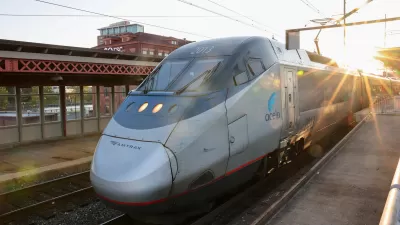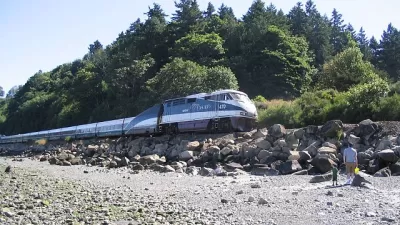Buoyed by increased revenue on its busiest lines on the Northeast Corridor plus new state contributions for some short-distance routes required by PRIIA, Amtrak's operating loss dropped 37 percent from last year while revenue grew by 8 percent.
Amtrak’s "revenue grew 8% to $3.2 billion from the previous fiscal year amid what transportation planners see as a long-term shift favoring mass transit and passenger rail," writes Andrew Tangel, who covers transportation for The Wall Street Journal. "Amtrak’s operating loss of $227 million in fiscal 2014, which ended Sept. 30, was down 37% from the previous year, according to results released Nov. 25 [PDF]."
Amtrak continues to require subsidies from the federal government, making it a "target of cost-cutters in Washington," notes Tangel. "In FY 2014 Congress provided a $340 million operating grant to Amtrak to cover operating losses," writes Tom Curry of Roll Call. "But the actual federally funded operating loss turned out to be about $227 million, the lowest level since 1973."
During the past nine years, ridership has grown almost 30 percent to 31 million in FY 2014, thanks in great part to the "Northeast Corridor, which includes the railroad’s Acela and Northeast Regional services," writes Tangel.
- The corridor enjoyed an operating surplus of $496.7 million in fiscal 2014, up from $390.1 million the previous year."
- Corridor "trains had 11.6 million passengers in FY2014, up 3.3 percent from the prior year," writes Curry.
- By contrast, Amtrak's long-distance service, "saw an operating loss of $507.5 million in fiscal 2014, narrower than the $594.2 million in the 2013 fiscal year, Amtrak said," writes Tangel.
In essence, northeast commuters are subsidizing money-losing trips on Amtrak's long distance lines which have long been the target of groups like the Reason Foundation, illustrated by this 2009 piece by science correspondent Ronald Bailey based on a Pew Charitable Trusts SubsidyScope Project.
However, success on the Northeast Corridor, comes with its own challenges, as Amtrak President Joseph Boardman indicated at a hearing on the future of the Northeast Corridor held in April last year before the Committee on Commerce, Science, and Transportation.
As for those payments, or 'contributions' from states, on October 8, 2013 we posted "our third update on the progress of states to reach funding agreements with Amtrak required by the Passenger Rail Investment & Improvement Act of 2008 (PRIIA) to continue to operate 28 regional routes (less than 750 miles long) excluding the Northeast Corridor in 19 states; earlier ones were posted May 6 and Sept. 13." PRIIA was reauthorized last September and now goes by the name Passenger Rail Reform and Investment Act of 2014 (PRRIA) [also posted here.]
Amtrak has a long ways to go before it can go unsubsidized, should that be a policy goal. The operating loss reported above "exclude(s) noncash depreciation and other items," writes Tangel. "Overall, the railroad reported a net loss of $1.1 billion in fiscal 2014, narrower than the $1.3 billion loss the previous year."
One possibility to reduce costs would be to look to the states for help with the long-distance lines. However, Tangel notes that it is "less clear" if Amtrak will go that route.
[Hat tip to Heather Caygle of Politico Morning Transportation.]
FULL STORY: Amtrak says its operating loss has fallen to the lowest level in 4 decades

Alabama: Trump Terminates Settlements for Black Communities Harmed By Raw Sewage
Trump deemed the landmark civil rights agreement “illegal DEI and environmental justice policy.”

Study: Maui’s Plan to Convert Vacation Rentals to Long-Term Housing Could Cause Nearly $1 Billion Economic Loss
The plan would reduce visitor accommodation by 25% resulting in 1,900 jobs lost.

Planetizen Federal Action Tracker
A weekly monitor of how Trump’s orders and actions are impacting planners and planning in America.

Wind Energy on the Rise Despite Federal Policy Reversal
The Trump administration is revoking federal support for renewable energy, but demand for new projects continues unabated.

Passengers Flock to Caltrain After Electrification
The new electric trains are running faster and more reliably, leading to strong ridership growth on the Bay Area rail system.

Texas Churches Rally Behind ‘Yes in God’s Back Yard’ Legislation
Religious leaders want the state to reduce zoning regulations to streamline leasing church-owned land to housing developers.
Urban Design for Planners 1: Software Tools
This six-course series explores essential urban design concepts using open source software and equips planners with the tools they need to participate fully in the urban design process.
Planning for Universal Design
Learn the tools for implementing Universal Design in planning regulations.
Caltrans
Smith Gee Studio
Institute for Housing and Urban Development Studies (IHS)
City of Grandview
Harvard GSD Executive Education
Toledo-Lucas County Plan Commissions
Salt Lake City
NYU Wagner Graduate School of Public Service





























